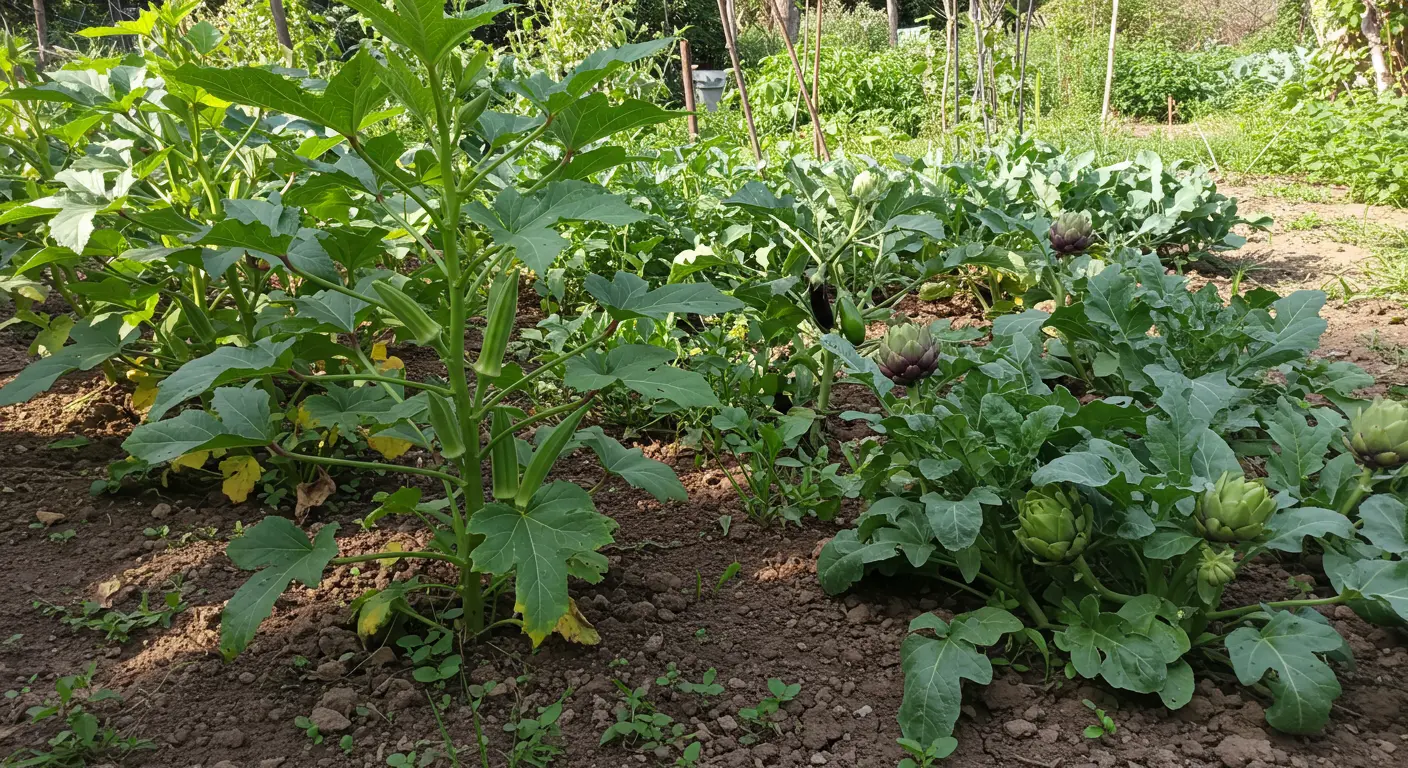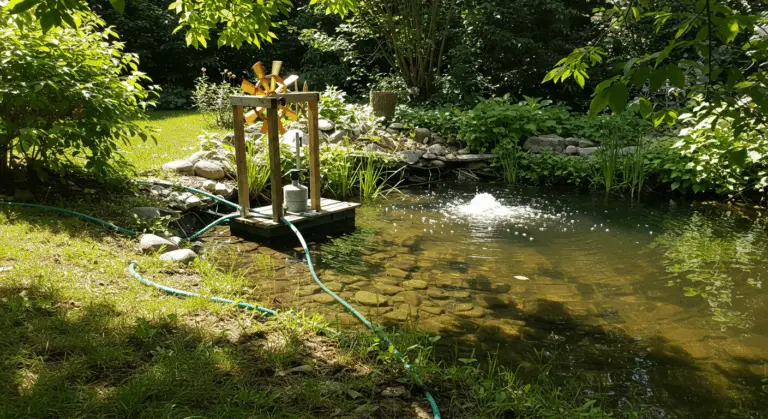Understanding Drought Tolerance in Vegetables
Drought tolerance in vegetables represents a plant’s innate ability to survive and produce yields with minimal water availability. This valuable trait has become increasingly important as climate change brings more frequent and severe dry periods to many growing regions worldwide. What makes a vegetable drought tolerant?
This resilience comes from evolutionary adaptations developed over millennia. Many drought-resistant vegetables develop deep, extensive root systems to access moisture far below the surface. They tap into reserves that shallow-rooted plants simply cannot reach.
Above ground, they often display physical traits that minimize water loss, such as:
-
Thick, waxy leaf coatings that seal in moisture.
-
Smaller leaf surfaces to reduce evaporation.
-
Specialized cell structures that store water efficiently.
-
Fuzzy or hairy leaves that trap humidity, creating a microclimate.
Okra, eggplant, and artichokes exemplify this water efficiency. However, even these resilient crops require consistent watering during their initial growth phase. This early investment allows them to develop the robust root systems that enable their future drought tolerance.
Understanding the difference between drought tolerance and drought resistance matters. Tolerance refers to a plant’s ability to maintain reasonable productivity despite water limitations. Resistance, by contrast, often indicates the plant can survive drought but may significantly reduce yield. The most valuable garden vegetables combine both traits—surviving dry periods while still providing a worthwhile harvest.
Top Drought Tolerant Vegetables to Grow
When planning a water-wise garden, selecting the right vegetables is essential. These resilient crops are adapted to thrive with minimal irrigation, making them ideal for dry regions or gardeners seeking to conserve resources.
Here are some top choices categorized by type:
-
Root Vegetables: Carrots, beetroot, and parsnips excel in dry conditions by seeking moisture deep in the soil.
-
Leafy Greens: Kale and Swiss chard are surprisingly resilient. Kale has robust, waxy leaves, while Swiss chard develops a deep taproot.
-
Fruiting Vegetables: This large category includes heat-loving eggplants, Mediterranean artichokes, and the entire squash family (e.g., zucchini, winter squash, melons), which all develop extensive root systems.
-
Heat-Loving Crops: Okra and many pepper varieties (especially chili) are evolved for hot, dry climates. Tomatillos also demonstrate excellent tolerance.
-
Perennials: Once established, rhubarb, asparagus, and Jerusalem artichokes (sun chokes) have massive root systems that withstand long dry spells.
-
Legumes and Others: Pole beans can continue producing in dry conditions. Arugula offers quick harvests before summer heat, and corn can yield with strategic, limited irrigation.
-
Specialty Crops: For extreme conditions, consider amaranth (for greens and grain) and Nogales (cactus pads), which thrive with very little water.
Okra – A High Drought Tolerance Vegetable
Okra stands as a top choice for water-conscious cultivation. This heat-loving crop thrives in conditions that stress many other vegetables, producing abundant pods with minimal irrigation.
Okra’s drought resistance stems from its deep root system and remarkably efficient water-use mechanisms. These adaptations allow it to remain productive when moisture becomes scarce.
Research has identified specific okra varieties with exceptional drought tolerance. Genotypes like LS05 and Area Abhay demonstrate superior performance in water-limited conditions. Their efficient water use, and strong root systems make them stand out. These varieties maintain productivity even when water is scarce, making them ideal choices for gardeners in arid regions.
Swiss Chard and Kale – Leafy Greens for Dry Climates
While many leafy greens wilt at the first sign of drought, Swiss chard and kale stand as remarkably resilient exceptions. These hardy greens produce abundant harvests even when water becomes limited.
Swiss chard distinguishes itself with exceptional drought tolerance compared to most other leafy vegetables. Its deep taproot reaches moisture far below the surface, while its broad leaves have developed ways to minimize water loss. This efficient water management system enables Swiss chard to maintain productivity through extended dry periods—times when lettuce and spinach would quickly bolt or wither.
Kale complements Swiss chard perfectly in the drought-resistant garden. It brings its own remarkable set of adaptations. The plant’s strong, fibrous roots extract available moisture efficiently. Its thick, often curly leaves feature a waxy cuticle that dramatically reduces evaporation. These physiological traits allow kale to thrive with minimal irrigation once established. Varieties like Laminate (Dinosaur) and Russian Red demonstrate particularly superior heat and drought tolerance.
The versatility of these greens extends far beyond their water efficiency. Unlike many vegetables that produce for only a brief season, properly maintained Swiss chard and kale plants can provide continuous harvests for months. In milder climates, they sometimes produce for years. This long harvest period makes them valuable in water-restricted gardens, providing good nutrition for minimal water use.
Fruits That Thrive in Drought Conditions
While vegetables often dominate drought-tolerant gardening discussions, several fruit-bearing plants have evolved remarkable adaptations. Allowing them to flourish with minimal water. Drought-resistant fruits offer gardeners in arid regions sustainable options for productive harvests while conserving precious water resources.
Many fruit-bearing plants are highly adapted to dry conditions:
-
Mediterranean Natives: Figs, pomegranates, and olives are exceptional performers. Figs have deep roots, pomegranates are long-lived with minimal irrigation, and olives have extreme endurance.
-
Arid-Adapted Exotics: Date palms, jujubes (Chinese dates), and the prickly pear cactus thrive in very dry climates, with the latter surviving in near-desert conditions.
-
Temperate Fruits: Once established, mulberries, certain grape varieties (especially for wine), and the hardy Arctic kiwi variety also demonstrate considerable drought resistance.
Perennial fruit crops offer significant advantages in water-restricted gardening compared to annual vegetables. Their established root systems penetrate deeper soil layers, accessing moisture unavailable to shallow-rooted annuals. Consider allocating more garden space to drought-tolerant soft fruits like certain raspberry varieties. Include dual-purpose perennials like rhubarb, globe artichokes, and asparagus that provide both edible harvests and exceptional drought resistance. This approach creates a garden that becomes increasingly resilient to water shortages with each passing season as perennial root systems develop and expand.
Best Practices for Drought-Tolerant Gardening
A successful drought-tolerant garden requires more than just selecting the right plants. It requires implementing water-efficient practices that work with nature.
Soil preparation forms the foundation of drought-resistant gardening. Incorporate abundant organic matter such as compost, aged manure, or leaf mold into your garden beds. This greatly improves the soil’s water-holding capacity while enhancing drainage—a seemingly contradictory but important combination. Well-amended soil acts like a sophisticated sponge. It absorbs rainfall or irrigation water and releases it gradually to plant roots. For clay soils, adding organic material creates essential air pockets that prevent waterlogging. In sandy soils, it provides structure that prevents rapid drainage and nutrient leaching.
Mulching stands as perhaps the single most effective water conservation technique available to gardeners. A 2-4 inch layer of organic mulch—such as straw, shredded leaves, grass clippings, or wood chips—can reduce evaporation by up to 70%. This dramatic reduction makes mulching one of the most valuable techniques for water conservation. Beyond water retention, mulch moderates soil temperature extremes, suppresses water-stealing weeds, and gradually decomposes to further enrich the soil. Apply mulch after the soil has warmed in spring, keeping it slightly away from plant stems to prevent rot issues.
Irrigation methods matter significantly in water-restricted gardening. Drip irrigation and soaker hoses deliver water precisely where needed—at the root zone. This minimizes waste through evaporation or runoff. These systems use 30-50% less water than conventional sprinklers while promoting healthier plants by keeping foliage dry, which reduces disease pressure. When establishing a new garden, consider investing in a simple timer-controlled drip system. The investment pays off in both water savings and reduced maintenance.
Strategic plant placement through hydrozoning—grouping plants with similar water requirements together—optimizes irrigation efficiency. Create distinct garden zones based on water needs. Place drought-resistant crops like okra and eggplant in naturally drier areas while reserving precious water resources for thirstier plants. This approach prevents both under-watering tough plants and over-watering sensitive ones, resulting in healthier growth throughout your garden.
Proper watering timing significantly impacts effectiveness. Water deeply but infrequently, preferably during early morning hours when evaporation rates are lowest and plants can utilize moisture throughout the day. This encourages roots to grow deeper in search of water, creating more resilient plants. Avoid evening watering when possible. Prolonged leaf moisture overnight can promote fungal diseases in many vegetables.
Finally, consider implementing rainwater harvesting systems to capture this free resource during wet periods. Even modest rain barrel setups can collect significant amounts of water from roof runoff. They provide chemical-free irrigation during dry spells. More ambitious gardeners might explore contour berms, sales, or rain gardens that slow, spread, and sink rainwater directly in the landscape, maximizing natural precipitation effectiveness.
Water-Saving Techniques for Gardeners
Consider installing rain sensors or smart irrigation controllers that automatically adjust watering schedules based on local weather conditions. These technologies can reduce water usage by 15-30% compared to traditional timers. They prevent irrigation during or immediately after rainfall. For container gardens, self-watering planters with water reservoirs can cut water use by up to 50% while providing consistent moisture to plants.
Windbreaks created from trellises, fences, or strategically placed taller plants can significantly reduce evaporation rates in windy areas. Wind accelerates moisture loss from soil and leaves dramatically. Sheltering your garden preserves precious water. Similarly, providing afternoon shade for sensitive crops during the hottest part of summer can reduce water requirements while preventing heat stress.
Water recycling presents another compelling opportunity for conservation. Collecting “gray water” from household sources like shower runoff or air conditioner condensate can provide supplemental irrigation. Cooled water from rinsing vegetables or boiling pasta can also find new life in the garden. When harvesting rainwater, consider adding first-flush diverters to your collection system to prevent roof contaminants from entering your storage barrels.
Finally, regular garden maintenance plays a crucial role in water conservation. Promptly removing spent plants and replacing them with seasonally appropriate crops ensures you’re not wasting water on unproductive garden space. Regularly checking irrigation systems for leaks or blockages prevents water waste. Periodic soil testing helps maintain optimal growing conditions that maximize water efficiency.
Challenges and Considerations for Drought Gardening
While drought-tolerant gardening offers numerous benefits, it’s not without its challenges. One of the biggest obstacles is weed competition. Weeds are remarkably efficient at extracting moisture from soil, often outcompeting your cultivated plants for limited water resources. A single mature weed can steal gallons of water throughout a growing season. This makes consistent weed management essential for water conservation. Consider using thick organic mulch or landscape fabric to suppress weed growth without resorting to chemical herbicides that might harm beneficial soil organisms.
Soil moisture monitoring becomes increasingly critical in drought conditions. Unlike traditional gardening where visual plant wilting might prompt watering, drought gardening requires a more proactive approach. Invest in a soil moisture meter to accurately gauge subsurface conditions. The surface may appear dry while deeper soil layers retain adequate moisture. Alternatively, the simple “finger test” (inserting your finger 2–3 inches into the soil) can provide a quick assessment of moisture levels. Developing this monitoring habit prevents both under-watering, which stresses plants, and over-watering, which wastes precious resources.
Climate variability presents another significant challenge. Unexpected heat waves or extended dry periods can push plants beyond their tolerance thresholds, particularly during critical growth stages like flowering or fruit set. Creating buffered microclimates within your garden can help mitigate these extremes.
Soil quality management becomes more complex in drought conditions. Sandy soils drain quickly and may seem problematic. Heavy clay soils can be equally challenging, often repelling water initially and causing runoff before slowly absorbing moisture. Regular incorporation of organic matter is essential for improving both soil types, but requires a balanced approach. Too much compost in sandy soil can actually increase drainage rates. Consider conducting a soil test specifically focused on water retention capacity to guide your soil amendment strategy.
Finally, drought gardening requires adjusting expectations about plant appearance and yield. Even successful drought-tolerant vegetables may appear less lush than their water-intensive counterparts. Plants naturally reduce leaf size and number to conserve water. This adaptation can be mistaken for poor health. Similarly, yields may be somewhat reduced compared to heavily irrigated gardens, though the trade-off in water conservation and resilience is often worth this compromise. Focus on quality over quantity. Celebrate the remarkable adaptability of plants that continue producing food with minimal water input.




